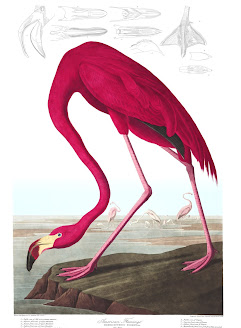Ennui, brought on by the lock-down, has been mitigated for many of us by the simple joys of reading . In my case, by re-reading some books about bird art and artists.Two of the great bird artists from the 19th century were, of course, John Gould and John James Audubon. Their timeless illustrations have delighted many who appreciate birds and bird art.
But this particular post is not about either Gould or Audubon. Rather, it is about Edward Lear.
Edward Lear?
If the name does sound familiar to most people, it's because people remember him for his nonsense verse. For his limericks. Those familiar with his art probably appreciate his landscape paintings. Indeed, the success of his professional career is measured by his considerable achievements as a landscape artist.
However, for some of us Lear is best remembered for his bird illustrations.
A Common Crane. Poised, with understated elegance. For sure one of Peter Matthiessen's 'Birds of Heaven'.
To truly appreciate Lear's bird art, you have to place it in context: not just that it is almost 200 years old, but also that he was one of the first to use the new process of lithography. A technique which he quickly mastered.
But for me, Lear is special because he drew his sketches (which were developed later into his masterpieces) from live specimens of birds in European zoos and private menageries. He would not have had the luxury of seeing many of these birds in their natural habitat.
Yet, the discerning eye will certainly note that his illustrations have an extraordinary 'true-to-life' quality. A naturalness, a ring of authenticity. From observations of captive specimens he was able to project in his drawings how the birds would actually appear and behave if you were to see them today in their wild surroundings.
His technique - of placing the finely delineated bird upfront in the observer's face while muting the background in monochrome or subtle shades - has often been copied but never surpassed.
Lear cut his teeth in the art world with his very own production of lithographs of parrots.
Also parakeets, lories, lorikeets, cockatoos and macaws- for his original aim was to cover all the birds of the parrot family from all over the world.
A macaw. Perched, as if with a conspiratorial air, on the shoulder of a pirate.
A pair of parakeets. Plumed and crested, with blushing cheeks.
Disappointingly, after starting in 1830, Lear had to abandon his parrot series within a couple of years. He published just 42 plates.
Even though the illustrations were critically acclaimed in London, with many aristocrats subscribing to his publications, the project was not a commercial success, mainly because some of his subscribers failed to pay.
For the next few years Lear's life was inextricably linked with that of John Gould. Employed by Gould, he illustrated many of the standout plates for some of Gould's masterful series of publications: The Birds of Europe, Birds of Asia, Birds of Australia, among others.
Here are some of these illustrations by Lear-
A pair of Ospreys. With rather disgruntled expressions, like those of anglers contemplating their private lake where poachers have cleaned out all the fish overnight...
Or a large solemn-looking owl with faintly unfocused eyes. Drawn thus perhaps because Lear understood that the round facial discs funnel and amplify sound to the ears? Many owls are hunters more by sound than by sight.
Dalmatian Pelicans. Also familiar to us in the Indian subcontinent. Beautifully drawn with that untidy tuft of feathers on the back of the head and nape (an identification feature that a birder would appreciate).
A Greylag Goose. Always elegant in flight or in the water, but here animated on land too, with its distinctive web-footed waddle.
A pair of night herons stealthily navigating through the waterside vegetation.
Purple herons are widely distributed across Europe, Asia and Africa.
Lear also illustrated some of the toucans and trogons that Gould produced as separate series of lithographs.
Again, the plates that Lear drew have their own distinctive stamp. Of animation and liveliness. The toucans, for instance, with their enormous bills, and bright-eyed piercing gazes...
One of the books now open in front of me, 'Edward Lear - A Life of Art and Nonsense' by Jenny Uglow, is a sheer delight. Almost every page is peppered with Lear's poetry and limericks and sketches and the text is enlivened by the author's obvious enthusiasm in sharing Lear's life with the reader.
In 1837 Edward Lear would begin his travels in Europe in search of his calling as a landscape artist. His journeys over the next few decades would take him from Europe to the Levant, to Africa and even to India.
His travels are recorded for posterity in the form of daily journals: the written observations are often hilarious, and the text is accompanied by rapid-fire sketches and drawings of the people, the landscapes, the birds and the animals.
Vidya Dehejia's 'Impossible Picturesqueness: Edward Lear's Indian Watercolours, 1873-1875' brings to life his Indian journal and the hundreds of drawings that he swiftly dashed off as he traveled across the country in fourteen months. He was now in his early sixties, and this would be the last of his major expeditions outside of Europe.
Kanchenjunga from Darjeeling. The chorten beside the path, the ferns and creeper-festooned trees frame the Kanchenjunga massif in the distance.
Lear would continue to write and to draw the characters that inhabit his verse and to publish his 'books of nonsense' which delight us to this day. In this particular genre he is right up there with Lewis Carroll.
The sharp-nosed portly gentleman is a self-caricature of Lear himself...
Lear himself can close this post with an extract from one of his poems:
Herons and Gulls, and Cormorants black,
Cranes, and Flamingoes with scarlet back,
Plovers and Storks, and Geese in clouds,
Swans and Dilberry Ducks in crowds.
Thousands of Birds in wondrous flight!
Sahdev Singh
Jaipur
July 2020

.jpeg)

















































